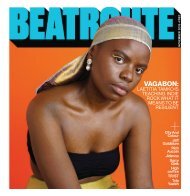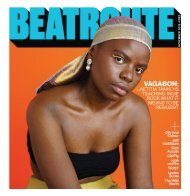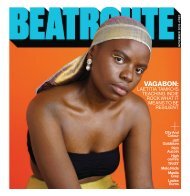BeatRoute Magazine [AB] print e-edition - [March 2018]
BeatRoute Magazine is a monthly arts and entertainment paper with a predominant focus on music – local, independent or otherwise. The paper started in June 2004 and continues to provide a healthy dose of perversity while exercising rock ‘n’ roll ethics.
BeatRoute Magazine is a monthly arts and entertainment paper with a predominant focus on music – local, independent or otherwise. The paper started in June 2004 and continues to provide a healthy dose of perversity while exercising rock ‘n’ roll ethics.
You also want an ePaper? Increase the reach of your titles
YUMPU automatically turns print PDFs into web optimized ePapers that Google loves.
IRISH WATERSHED<br />
Running parallel and sometimes intersecting the showbands, there was a revival of traditional Irish folk<br />
in the ‘60s led by The Chieftains, The Clancy Brothers and The Dubliners, to name a few. Keeping the<br />
dance halls filled and drinking flowing, there were a few novelty showboaters as well – Paddywagon<br />
wore black and white prison stripes as their stage outfits. By the early-70s another, much broader form<br />
of the folk revival would take shape with Planxty and Clannad, bands that dove deep into the roots of<br />
Irish music employing a multitude of musicians and instruments. At the same time, Celtic rock began to<br />
emerge largely following Thin Lizzy’s “Whiskey In The Jar” in which The Horslips are rightly cited as the<br />
“founding fathers” of the genre while pushing it into prog-folk.<br />
The Irish had its special take on being punk. Certainly The Pogues put punk into folk like no band<br />
before, aside from Dylan going electric with The Band. And while Stiff Little Fingers’ assault tactics are on<br />
par with The Clash, The Undertones were absolute gems, a brilliant debut in 1978 with “Teenage Kicks”<br />
oozing with what it meant to be young, unprivileged, perplexed but glad to be fucking alive! Boomtown<br />
Rats were a lot more scrappy, but wore their soul on their sleeve just as well. They kicked out their<br />
teenage lust in “Mary Of The Fourth Form” and stole Springsteen’s thunder with “Rat Trap” showing Mr.<br />
Boss Man how to punk-it-up.<br />
Then the elephant in the room – the paradox of U2. Given Bono is such a mouthpiece, his lyrical<br />
contributions vague and often vacuous. Yes, the guy has a magnificent voice, clearly a cut above when<br />
he rose to belting out “Pride (In The Name Of Love). But without meaningful language, too often it’s just<br />
sonic veneer –paging through the beauty and glamour of Vogue <strong>Magazine</strong>, a delight to look at but not<br />
something that really penetrates too deep. And what would the band be without Bono wailing away?<br />
There’s no with or without you, it’s with Bono or no U2. Hey, millions (yes, millions) of fans around the<br />
globe are with them as well!<br />
Despite the thin pop minimalism but great rock ‘n’ roll accomplishment (paradox), U2, like Van<br />
Morrison, was a game changer. They did swing open the door for a whole new wealth of Irish talent in<br />
the form of That Petro Emotion, The Cranberries, The Coors and, of course, Sinead O’Connor.<br />
While praised for her cover of Prince’s “Nothing Compares 2 U”, O’Connor scales many walls and is as<br />
proactive as it gets in life and in song, where one reflects the other. Her 2014 recording “8 Good Reasons”<br />
is a harrowing descent into near suicide, if not literal, certainly a metaphorical and compelling account<br />
on saving the soul by penetrating the soul. And that’s really the beauty of good Irish music, soul diving,<br />
which is why so many artists drift towards the Emerald Isle.<br />
Irish diaspora refers to ex-pats or those who claim they’re descendants of Ireland reaching back to<br />
either claim or expose their ancestral roots. Paul McCartney had a hit single in 1972 with his protest<br />
ditty “Give Ireland Back To The Irish” proclaiming his heritage in response to the violence that pro-<br />
ST. PADDY’S SONG AND DANCE<br />
more than a few tunes to drink to<br />
BY B. SIMM<br />
St. Paddy’s is a good day for drinkin’. In fact, most days are! But it’s often discouraging to bear the<br />
onslaught of a non-stop playlist of Irish drinking songs where many only made the list not necessarily<br />
because they’re good songs, but because they’re “drinkin’ songs”. It can spoil a good day of celebrating.<br />
You deserve better, the Irish deserve better.<br />
And those Irish are a tuneful lot. Their Celtic souls immersed in music ranging from traditional to<br />
modern, from minimal to multi-layered that occupies a sprawling spectrum of sound and cultural complexity<br />
that far surpasses those simple tunes to toast to. By no means can you begin to encapsulate the<br />
depth and breath of the Irish in a few paragraphs, but when constructing that St. Patrick’s playlist here’s a<br />
few hall-of-famers that should be noted, if for nothing else, a starting place to explore your inner Irish.<br />
In the States during the early-60s, especially in the wake of Beatlemania, an all new All-American sport<br />
cropped up where legions of young, white males formed garage bands bashing out gnarly, three-chord<br />
R&B numbers trying their best to imitate not John and Paul so much as their black superheroes – Chuck<br />
Berry, Little Richard and James Brown.<br />
To lesser degree, the garage band phenomenon also took hold in Europe, Asia, Japan, Latin American<br />
and down under in Australia as the shock waves of the British Evasion rippled across the planet. In<br />
Ireland, a similar, but unique variant of garage rock was already in the works pre-Beatlemania.<br />
The profound effect Glenn Miller, Sinatra, Bill Hayley and Elvis had on the English-speaking world<br />
perhaps moved the Irish more than other nations outside America. In response to Ol’ Blue Eyes and the<br />
King of Rock ‘n’ Roll, “showbands” sprouted up all over the country performing and playing hit singles<br />
many Irish didn’t have access to because radio stations rarely embraced pop music and record stores<br />
were far and few between. By the 1960s showbands swelled into the hundreds and easily criss-crossed<br />
the notorious border, which divided the Irish on the political and religious front, but couldn’t constrain a<br />
van packed full of musicians and gear.<br />
Many of the showbands were led by versatile singers, some became national sensations, seguing<br />
between Elvis, crooners like Sinatra and Gene Autry while dabbling in Irish tradition. The game changer<br />
would be Van Morrison.<br />
THEM and VAN<br />
Morrison sang, played sax and harp in a showband called the Monarchs who toured Ireland as well<br />
as US Army bases in Britain and Germany. Caught up in the R&B explosion that spawned the Rolling<br />
Stones, he formed Them in Belfast who had the same gritty blues delivery as the Stones and the Animals.<br />
After touring the States on the strength of “Baby Please Don’t Go”, “Here Comes The Night” and<br />
what became thee garage anthem, “Gloria”, Morrison on his return to Ireland was disenchanted with<br />
typical band bullshit and left. Soon after he recorded the single “Brown-Eyed Girl” which eventually led<br />
to a record deal with Warner Bros.. Drawing on a mass of influences, Morrison crafted a magical fusion<br />
of folk, pop, R&B, soul, jazz and rock ‘n’ roll found on the albums Astral Weeks, Moondance and St. Domenic’s<br />
Review. An Irish alchemist who bridged the vast expanse of Celtic consciousness with everything<br />
under the American sun, he cracked open a seminal universe filled with poetry and music.<br />
RORY GALLAGER<br />
Still not a household name alongside the Hendrix, Page, Clapton, Blackmore, Beck list of who’s who<br />
of guitarists, but was well-known and well-respected by all of the first generation guitar greats. Raised<br />
in Cork, Gallagher also joined a showband where he honed his skills on what is reputed to be the first<br />
Fender Stratocaster to be shipped to Ireland which he bought in 1963. By 1966 he led the blues-rock trio<br />
Taste and then formed a band under his own name in 1970. A fiery guitarist-blues purist, Gallagher also<br />
had an incredible, irresistible voice and could pen passionate, flowing, bursting-at-the-seams rock ‘n’ roll<br />
numbers, yet he and his songs were Irish to the core.<br />
THIN LIZZY<br />
It’s impossible to mention Thin Lizzy without thinking of Phil Lynott, the band’s charismatic black frontman,<br />
a hybrid of Jimi Hendrix and every great American soul singer. Like Gallagher, in the mid-60s Lynott<br />
led a semi-successful blues-rock band, Skid Row, before moving on to Thin Lizzy in 1969. The first two albums<br />
were not impressive, but after recording a galloping, soulful version of the trad ballad, “Whiskey In<br />
The Jar,” things started looking up. While Thin Lizzy is renown for their swagger and searing, dual-guitar<br />
leads and gate-crashing force of “Jailbreak” and “The Boys Are Back In Town”, there’s another side to the<br />
band that rests in Lynott’s tender moments and recollections of his Irish youth. “Girl In Bloom” off 1973’s<br />
Vagabonds Of The Western World is one of the most heartfelt mini-dramas ever written about teenage<br />
pregnancy. While “Dancing In The Moonlight”, their post-Jailbreak single, a clear indication Lynott was<br />
deemed to take the airwaves and top the charts if he had kicked the habit.<br />
24 | MARCH <strong>2018</strong> • BEATROUTE<br />
Van the Man<br />
Boston 1968


![BeatRoute Magazine [AB] print e-edition - [March 2018]](https://img.yumpu.com/59988136/24/500x640/beatroute-magazine-ab-print-e-edition-march-2018.jpg)















